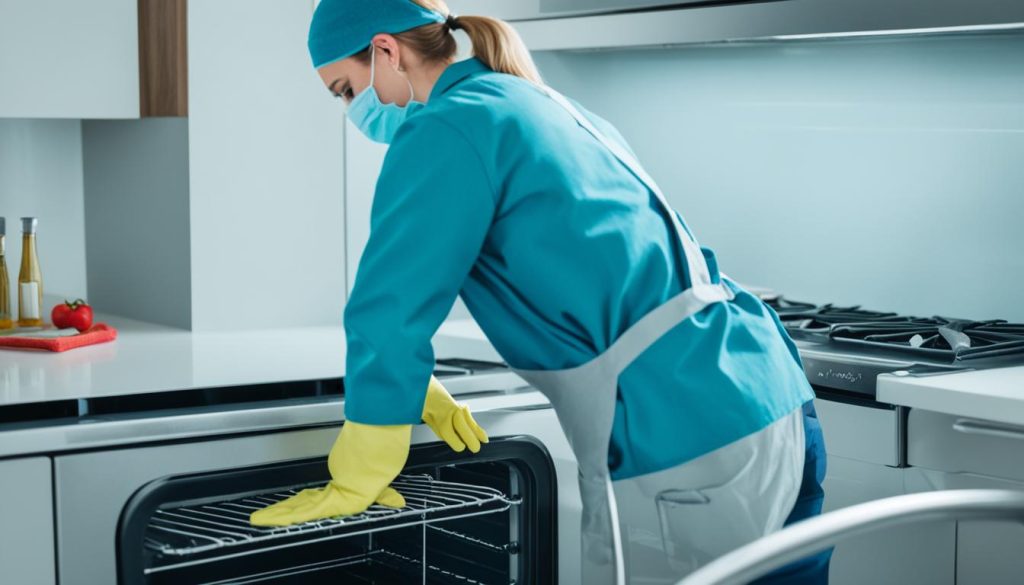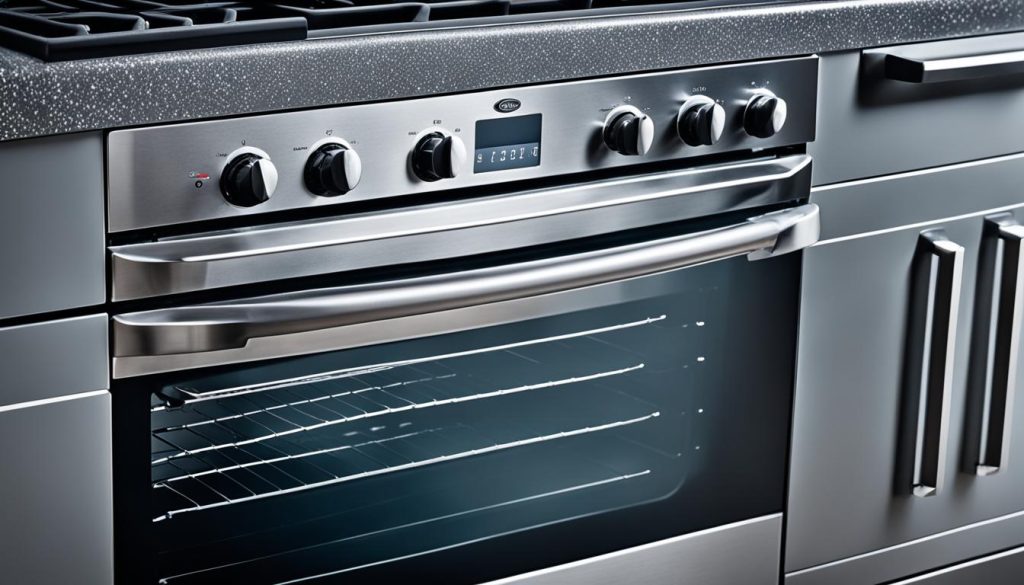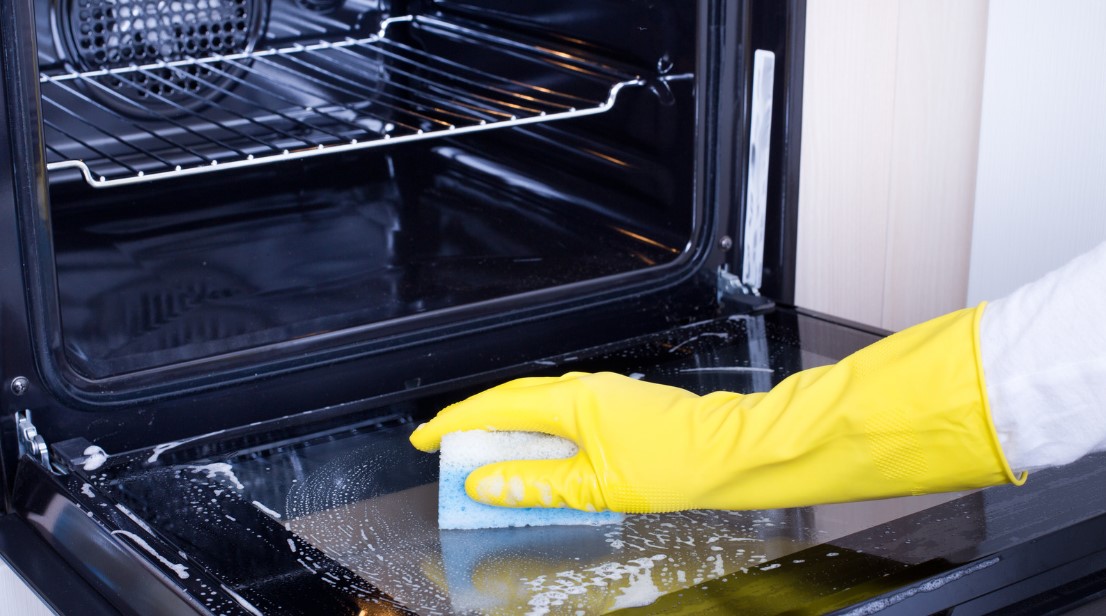Cleaning an oven can be a daunting task, but with the right steps, it can be a simple and effective process. By following these simple steps, you can achieve a sparkling clean oven without the use of harsh chemicals.
How to Clean an Oven?
Keeping your oven clean is essential for maintaining its performance and longevity. With this step-by-step guide, you’ll learn how to clean your oven effectively using simple and natural ingredients.
Gather Your Cleaning Materials
Before you begin cleaning your oven, make sure you have the necessary materials on hand:
- Baking soda
- Water
- Rubber gloves
- White vinegar
- A spray bottle
- A cleaning rag
Remove the Oven Racks
Start by taking out the oven racks and placing them aside. Cleaning them separately will ensure that they receive the attention they need.
Create a Baking Soda Paste
Mix baking soda with a small amount of water to create a paste. The paste should have a thick, spreadable consistency.
Apply the Baking Soda Paste
Using your gloved hands or a cleaning rag, apply the baking soda paste to the interior of the oven. Make sure to cover all areas, paying extra attention to any stubborn stains or build-up. Let the paste sit for at least 12 hours or overnight.
Clean the Oven Racks
While the baking soda paste is working on the oven, you can tackle the oven racks. Fill your sink or a tub with hot water and add a cup of white vinegar. Submerge the oven racks in the solution and let them soak for a few hours. After that, scrub away any remaining grime using a scrub brush or sponge. Rinse the racks thoroughly and set them aside to dry.
Wipe Away the Baking Soda Paste
After the baking soda paste has had enough time to work its magic, use a damp cloth or sponge to wipe away the paste from the oven’s interior. You may need to rinse and wring out the cloth or sponge multiple times during this process. Ensure you remove all traces of the paste, leaving the oven clean and residue-free.
Clean the Glass Door and Exterior
Don’t forget to clean the glass door and the exterior of the oven. Use vinegar diluted with water in a spray bottle for stubborn stains or grease. Spray it onto the surface and wipe it clean with a cloth or sponge.
Now, your oven is clean and ready to use for your next cooking adventure. Remember to regularly maintain your oven’s cleanliness to prevent build-up and ensure optimal performance. Happy cooking!
| Materials Needed | Steps |
|---|---|
| Baking soda | 1. Remove the oven racks |
| Water | 2. Create a baking soda paste |
| Rubber gloves | 3. Apply the baking soda paste |
| White vinegar | 4. Clean the oven racks |
| A spray bottle | 5. Wipe away the baking soda paste |
| A cleaning rag | 6. Clean the glass door and exterior |
How Often Should You Clean Your Oven?
The cleanliness of your oven depends on how often you use it. To ensure it remains in top condition and avoid any harmful build-up, it is recommended to give your oven a deep clean every three months if you use it frequently. This regular maintenance will help prevent the accumulation of grease, food particles, and burnt residue, which can affect the performance of your oven and even create safety hazards.
However, if you use your oven less frequently, such as for occasional baking or cooking, you can opt to clean it once or twice a year. It is important to note that even if you use your oven infrequently, it can still accumulate grease and residue over time. Regular spot cleaning, such as wiping up spills and splatters as they occur, can help maintain the cleanliness of your oven in between deep cleaning sessions.
Cleaning your oven regularly not only keeps it hygienic and odor-free but also helps extend its lifespan. Additionally, a clean oven promotes even heat distribution, allowing your dishes to cook more evenly and preventing any unwanted flavors from lingering on your food.
Tips for Safe Oven Cleaning
When cleaning your oven, it is essential to prioritize safety to avoid any mishaps or accidents. Here are some tips to ensure safe oven cleaning:
- Always wear protective gloves to shield your hands from harsh chemicals and hot surfaces.
- Make sure the oven is switched off and cool before starting the cleaning process.
- Remove any loose debris, such as crumbs or large food particles, before applying any cleaning agents.
- If using commercial oven cleaners, read the instructions carefully and follow the recommended safety precautions.
- When using natural cleaning solutions like baking soda and vinegar, ensure proper ventilation and avoid inhaling any fumes.
- Take extra caution when cleaning the oven door to avoid scratching the glass.
By following these tips and establishing a regular cleaning routine, you can maintain a clean and safe oven for all your cooking needs.

Self-Cleaning vs. Manual Cleaning
When it comes to cleaning an oven, there are two methods you can choose from: self-cleaning and manual cleaning. Each method has its own benefits and considerations.
Self-Cleaning Ovens
Self-cleaning ovens use high heat to burn off grime and residue, making the cleaning process much easier. Once the self-cleaning cycle is complete, all that’s left is a small amount of ash that can be easily wiped away. This method eliminates the need for harsh chemicals or commercial oven cleaners, making it a safer option for your oven and the environment.
However, it’s important to read and follow the manufacturer’s instructions for your specific self-cleaning oven. The high heat during the self-cleaning cycle can cause smoke and strong odors, so proper ventilation is essential. It’s also important to ensure that the oven is completely cool before wiping away the ash.
Manual Cleaning
If you prefer a more hands-on approach, manual cleaning is a popular choice. This method involves using natural solutions such as baking soda paste and vinegar to scrub away dirt and grease from the oven’s interior. It’s important to remove the oven racks and clean them separately to ensure a thorough cleaning.
To clean the interior of the oven, create a paste using baking soda and water. Apply the paste to the oven walls, focusing on areas with burnt grease or stubborn stains. Let the paste sit for a few hours or overnight to help lift away the grime. Then, using a damp cloth or sponge, wipe away the paste and rinse the surface with water. For the oven racks, soak them in hot water with dish soap or a mixture of vinegar and water before scrubbing away the grime.
When cleaning the glass oven door, be sure to use a non-abrasive cleaner to avoid scratching the surface. A mixture of vinegar and water or a commercial glass cleaner can be used to remove any grease or stains. Wipe the door clean with a microfiber cloth or paper towel for a streak-free finish.
Both self-cleaning and manual cleaning methods have their advantages, and the choice ultimately depends on personal preference. Remember to clean your oven regularly to ensure it remains safe to cook in and free from burnt grease and residue.

| Self-Cleaning | Manual Cleaning |
|---|---|
| Uses high heat to burn off grime and residue | Uses natural solutions like baking soda and vinegar |
| No need for harsh chemicals or commercial oven cleaners | Requires the use of natural cleaning agents |
| May produce smoke and strong odors during the self-cleaning cycle | Can be done with minimal odor or smoke |
| Leaves behind a small amount of ash that can be easily wiped away | Requires manual scrubbing and rinsing to remove grime |
| Important to follow the manufacturer’s instructions and ventilate the area properly | Requires proper ventilation and caution when using cleaning agents |
Conclusion
Cleaning an oven may seem like a daunting task, but with the right techniques and cleaning agents, it can be a relatively easy process. Regular oven cleaning is essential for maintaining the cleanliness and functionality of your oven. Whether you choose to use the self-cleaning feature or opt for a more manual approach, you can achieve a deep, thorough clean.
To make the process even simpler, you can implement some easy oven cleaning hacks. For lightly cleaning the oven, using baking soda paste and vinegar can help remove stubborn stains and grease stains. For a deep clean, removing the oven racks and soaking them in hot water can effectively remove built-up grime and residue.
By keeping your oven clean, you not only ensure that it is safe to cook in but also enhance its performance. A clean oven distributes heat evenly, preventing any burnt grease or residue from affecting the flavor of your meals. So follow these easy cleaning tips and enjoy delicious dishes without worry.

